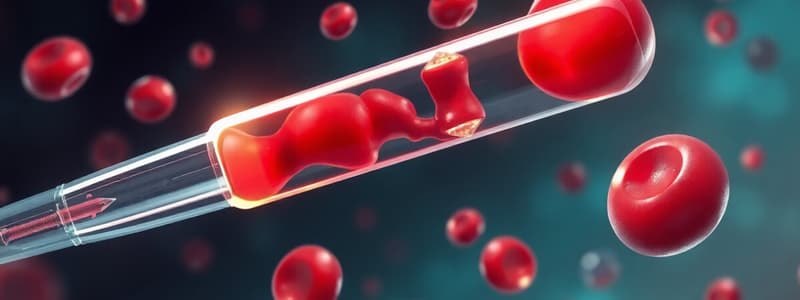Podcast
Questions and Answers
What is the normal hemoglobin level range for pregnant women?
What is the normal hemoglobin level range for pregnant women?
- 11 to 12 g/dl (correct)
- 13 to 18 g/dl
- 11 to 16 g/dl
- 12 to 16 g/dl
Which component of hemoglobin is responsible for its red color?
Which component of hemoglobin is responsible for its red color?
- Proteins
- Erythropoietin
- Iron (correct)
- Globin
What is the primary function of hemoglobin in the bloodstream?
What is the primary function of hemoglobin in the bloodstream?
- Transporting oxygen and carbon dioxide (correct)
- Regulating body temperature
- Producing red blood cells
- Transporting nutrients
What percentage of hemoglobin in normal adults is HbA?
What percentage of hemoglobin in normal adults is HbA?
Which method for hemoglobin estimation can measure the oxygen combining capacity of hemoglobin?
Which method for hemoglobin estimation can measure the oxygen combining capacity of hemoglobin?
Which chain is found in fetal hemoglobin instead of beta chains?
Which chain is found in fetal hemoglobin instead of beta chains?
What is a possible cause for an increase in hemoglobin concentration?
What is a possible cause for an increase in hemoglobin concentration?
What is the disadvantage of Sahli's method for estimating hemoglobin levels?
What is the disadvantage of Sahli's method for estimating hemoglobin levels?
What is the makeup of a hemoglobin molecule in terms of polypeptide chains?
What is the makeup of a hemoglobin molecule in terms of polypeptide chains?
What is one function of hemoglobin related to blood pH?
What is one function of hemoglobin related to blood pH?
What is the primary use of hydrochloric acid (HCl) in the Sahli’s method?
What is the primary use of hydrochloric acid (HCl) in the Sahli’s method?
Which of the following describes a limitation of the Sahli method?
Which of the following describes a limitation of the Sahli method?
What process is used to match the color of the hematin solution in the Sahli method?
What process is used to match the color of the hematin solution in the Sahli method?
How is blood introduced into the Sahli tube during the procedure?
How is blood introduced into the Sahli tube during the procedure?
What does the intensity of the color resulting from hematin indicate?
What does the intensity of the color resulting from hematin indicate?
What is the initial step in preparing the hematin solution using the Sahli method?
What is the initial step in preparing the hematin solution using the Sahli method?
Which of the following is NOT a tool involved in the Sahli's kit?
Which of the following is NOT a tool involved in the Sahli's kit?
What should be done to mix the blood and HCl according to the Sahli method?
What should be done to mix the blood and HCl according to the Sahli method?
During the Sahli procedure, why must air be prevented from entering the pipette column?
During the Sahli procedure, why must air be prevented from entering the pipette column?
Flashcards
Hemoglobin
Hemoglobin
The main component of red blood cells (RBCs) responsible for the blood's red color.
Normal Haemoglobin Levels
Normal Haemoglobin Levels
Normal Hb levels vary among individuals due to factors like age, sex, and pregnancy.
Hemoglobin Structure
Hemoglobin Structure
Hemoglobin has two main parts, a pigment called heme and a protein called globin.
Hemoglobin Molecule
Hemoglobin Molecule
Signup and view all the flashcards
HbA
HbA
Signup and view all the flashcards
HbA2
HbA2
Signup and view all the flashcards
HbF (Fetal Hemoglobin)
HbF (Fetal Hemoglobin)
Signup and view all the flashcards
Hemoglobin Function (Oxygen and CO2 Transport)
Hemoglobin Function (Oxygen and CO2 Transport)
Signup and view all the flashcards
Hemoglobin Function (pH Regulation)
Hemoglobin Function (pH Regulation)
Signup and view all the flashcards
Hemoglobin Breakdown
Hemoglobin Breakdown
Signup and view all the flashcards
Sahli's Hemoglobin Determination Method
Sahli's Hemoglobin Determination Method
Signup and view all the flashcards
Hydrochloric Acid (HCl)
Hydrochloric Acid (HCl)
Signup and view all the flashcards
Hematn
Hematn
Signup and view all the flashcards
Color Comparison
Color Comparison
Signup and view all the flashcards
Sahli Tube
Sahli Tube
Signup and view all the flashcards
Blood Volume
Blood Volume
Signup and view all the flashcards
Hemoglobin Pipette
Hemoglobin Pipette
Signup and view all the flashcards
Reaction Time
Reaction Time
Signup and view all the flashcards
Distilled Water
Distilled Water
Signup and view all the flashcards
Final Color Comparison
Final Color Comparison
Signup and view all the flashcards
Study Notes
Hemoglobin Estimation
- Hemoglobin (Hb) is the primary component of red blood cells (RBCs), and gives blood its red color.
- Normal Hb levels vary by gender and age group.
- Women: 12 to 16 g/dL
- Men: 13 to 18 g/dL
- Children: 11 to 16 g/dL
- Pregnant women: 11 to 12 g/dL
- Hb is composed of two parts:
- Heme (iron containing pigment), which constitutes 4%
- Globin (protein), which constitutes 96%
- Hemoglobin consists of four heme groups, each attached to a protein chain. Two pairs of polypeptide chains form the hemoglobin molecule.
- In normal adults, hemoglobin is primarily HbA, with two alpha (α) chains (each containing 141 amino acids) and two beta (β) chains (each containing 146 amino acids).
- HbA2, comprised of two alpha chains and two delta (δ) chains. This accounts for about 2.5% of total hemoglobin.
- Fetal hemoglobin (HbF) is present in the blood of a fetus and has gamma (γ) chains in place of beta chains.
Sahli's Method
- A traditional method for estimating blood hemoglobin levels.
- Based on colorimetric measurement of converted hemoglobin to hematin.
- Advantages:
- Inexpensive reagents and equipment
- Easy to use and perform
- Quick results
- Doesn't require electricity
- Disadvantages:
- Can't measure all hemoglobin types
- Not suitable for detailed analysis
- Uses hydrochloric acid (HCl), which presents chemical hazards
- Less precise than automated methods
Procedure for Sahli's Method
- 5 drops of 0.1N HCl are placed in a graduated Sahli tube.
- Blood (20 µL) is added to the tube using a pipette.
- The blood and HCl are mixed, and the tube is allowed to stand for 10 minutes.
- Diluted water is added dropwise to the tube, and mixed until the color matches a standard solution.
Studying That Suits You
Use AI to generate personalized quizzes and flashcards to suit your learning preferences.
Related Documents
Description
Explore the fundamental concepts of hemoglobin estimation and the traditional Sahli's method in this quiz. Learn about the composition of hemoglobin and the normal levels across different demographics, along with the roles of various types of hemoglobin. Test your understanding of these vital topics in hematology.



